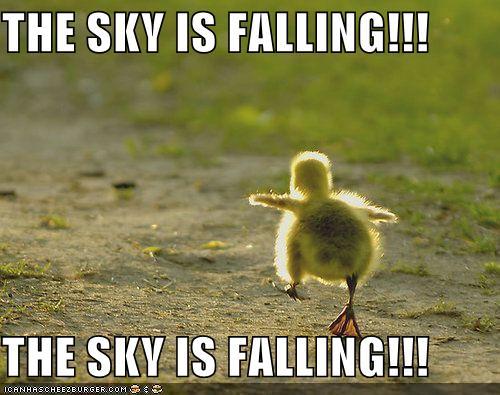The Sky is Falling – Again!
Christians love to think that the sky is falling or that the end is near. Every generation has their own doomsday calculations from the Bible about the end of times. This has become a favorite pastime and illustrates what Mark Noll says in Jesus Christ and the Life of the Mind – “evangelicals treat the Bible as a mechanical bequest from the skies in which verses function like puzzle pieces to be assembled according to the reader’s predetermined assumptions” (p.23) about how God should act.
For my generation, it was Hal Lindsay and The Late Great Planet Earth.
I remember vividly. As a senior, I was the de facto leader of the High School group in my church. We wanted to know about the end times – that’s all we could think about. This was in the midst of the Jesus movement in the United States and we were excited about God and Jesus. We wore our large fish symbol necklaces, carried huge Bibles with large puffy leather covers, went to Christian coffee houses with black-lights and worshiped to Amazing Grace sung to the tune of the House of the Rising Sun!
And part of the Jesus movement was the knowledge that Jesus was returning soon….and Hal Lindsay was there to help us predict when and who it would be!
M pastor didn’t want us to fall into the trap of spending all our energies on the second coming, but did allow us to spend a few weeks studying about it, with the one caveat that he would lead the first couple of sessions. We said yes – then suffered through his explanation that nobody really is certain about the second coming, and then learned of pre, post and ahhhhhhh (by then we were all sleeping). Finally it was time for Hal Lindsay!
It was a wonderful study. All the verses lined up, Jesus was coming back soon – probably within two years, and the anti-Christ was the Israeli leader Moshe Dayan.

Of course this just illustrates what happens when critical concern is edged out by emotion and a literal proof-text vision of the scriptures. Instead, Noll teaches that the Bible does not speak to everything, but that it speaks of the origin, redemption and purposes of all things.
He challenges the believer to let Jesus be the center for the task of all learning. Using the creeds as guideposts, we are to direct all inquiries toward Jesus, reminding evangelicals that the Jesus who saves sinners is the same Christ who “beckons his followers to use their minds for serious exploration of the world.” (p.41)
He elaborates, outlining four concerns to guide our learning, stressing the “come and see” aspect of the gospel. He challenges much of the assumptions evangelicals purport, reminding us that Christ-centered learning is about approaching the Bible with critical self-consciousness about “our own presuppositions” as a starting point.
He concludes by giving the reader some optimism, citing George Fox among those that are leading the way. Two other Grand Rapids institutions illustrate this optimism – Acton Institute and BioLogos.
I learned a new word in Noll’s first book and again I fell prey to a favorite new term in this work. “Effulgence” means a ‘brilliant light radiating from somewhere,” or “to shine forth.” All is not lost in evangelicalism and intellectual thinking as long as there are lights that shine forth, lights of hopefulness. As long as we focus on Jesus Christ in inquiries of all aspects of life; our purpose, reconciliation with god and engagement with this world, effulgence will be exhibited to all we encounter.
Leave a Reply
You must be logged in to post a comment.